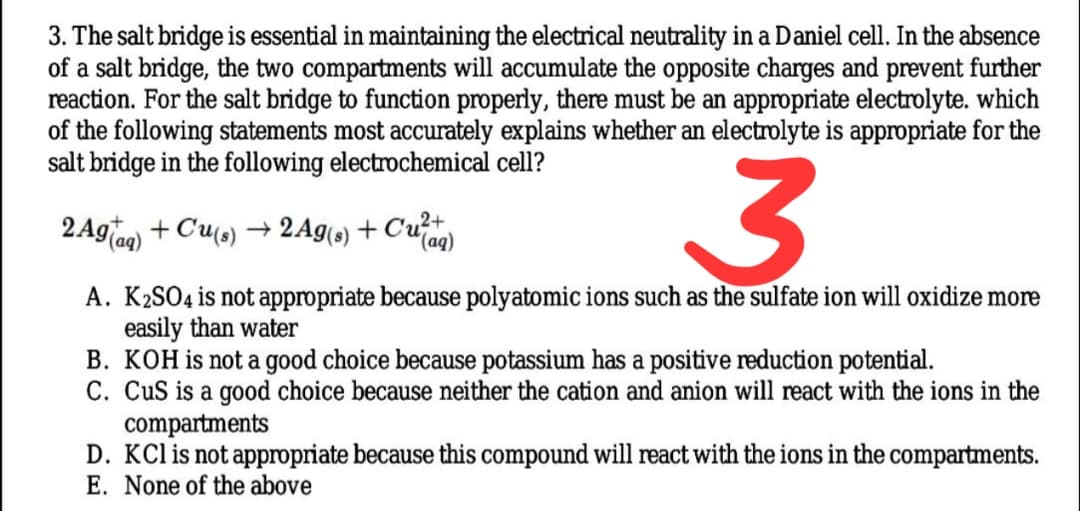3. The salt bridge is essential in maintaining the electrical neutrality in a Daniel cell. In the absence of a salt bridge, the two compartments will accumulate the opposite charges and prevent further reaction. For the salt bridge to function properly, there must be an appropriate electrolyte. which of the following statements most accurately explains whether an electrolyte is appropriate for the salt bridge in the following electrochemical cell? 2 Aglag) + Cu(s) → 2Ag(s) + Cu) A. K2SO4 is not appropriate because polyatomic ions such as the sulfate ion will oxidize more easily than water B. KOH is not a good choice because potassium has a positive reduction potential. C. CuS is a good choice because neither the cation and anion will react with the ions in the compartments D. KCl is not appropriate because this compound will react with the ions in the compartments. E. None of the above
3. The salt bridge is essential in maintaining the electrical neutrality in a Daniel cell. In the absence of a salt bridge, the two compartments will accumulate the opposite charges and prevent further reaction. For the salt bridge to function properly, there must be an appropriate electrolyte. which of the following statements most accurately explains whether an electrolyte is appropriate for the salt bridge in the following electrochemical cell? 2 Aglag) + Cu(s) → 2Ag(s) + Cu) A. K2SO4 is not appropriate because polyatomic ions such as the sulfate ion will oxidize more easily than water B. KOH is not a good choice because potassium has a positive reduction potential. C. CuS is a good choice because neither the cation and anion will react with the ions in the compartments D. KCl is not appropriate because this compound will react with the ions in the compartments. E. None of the above
Chemistry: The Molecular Science
5th Edition
ISBN:9781285199047
Author:John W. Moore, Conrad L. Stanitski
Publisher:John W. Moore, Conrad L. Stanitski
Chapter17: Electrochemistry And Its Applications
Section17.3: Voltaic Cells
Problem 17.3PSP
Related questions
Question

Transcribed Image Text:3. The salt bridge is essential in maintaining the electrical neutrality in a Daniel cell. In the absence
of a salt bridge, the two compartments will accumulate the opposite charges and prevent further
reaction. For the salt bridge to function properly, there must be an appropriate electrolyte. which
of the following statements most accurately explains whether an electrolyte is appropriate for the
salt bridge in the following electrochemical cell?
2 Aglag) + Cu(s) → 2Ag(s) + Cu)
A. K2SO4 is not appropriate because polyatomic ions such as the sulfate ion will oxidize more
easily than water
B. KOH is not a good choice because potassium has a positive reduction potential.
C. CuS is a good choice because neither the cation and anion will react with the ions in the
compartments
D. KCl is not appropriate because this compound will react with the ions in the compartments.
E. None of the above
Expert Solution
This question has been solved!
Explore an expertly crafted, step-by-step solution for a thorough understanding of key concepts.
Step by step
Solved in 2 steps with 2 images

Knowledge Booster
Learn more about
Need a deep-dive on the concept behind this application? Look no further. Learn more about this topic, chemistry and related others by exploring similar questions and additional content below.Recommended textbooks for you

Chemistry: The Molecular Science
Chemistry
ISBN:
9781285199047
Author:
John W. Moore, Conrad L. Stanitski
Publisher:
Cengage Learning

Chemistry & Chemical Reactivity
Chemistry
ISBN:
9781337399074
Author:
John C. Kotz, Paul M. Treichel, John Townsend, David Treichel
Publisher:
Cengage Learning

Chemistry & Chemical Reactivity
Chemistry
ISBN:
9781133949640
Author:
John C. Kotz, Paul M. Treichel, John Townsend, David Treichel
Publisher:
Cengage Learning

Chemistry: The Molecular Science
Chemistry
ISBN:
9781285199047
Author:
John W. Moore, Conrad L. Stanitski
Publisher:
Cengage Learning

Chemistry & Chemical Reactivity
Chemistry
ISBN:
9781337399074
Author:
John C. Kotz, Paul M. Treichel, John Townsend, David Treichel
Publisher:
Cengage Learning

Chemistry & Chemical Reactivity
Chemistry
ISBN:
9781133949640
Author:
John C. Kotz, Paul M. Treichel, John Townsend, David Treichel
Publisher:
Cengage Learning

General Chemistry - Standalone book (MindTap Cour…
Chemistry
ISBN:
9781305580343
Author:
Steven D. Gammon, Ebbing, Darrell Ebbing, Steven D., Darrell; Gammon, Darrell Ebbing; Steven D. Gammon, Darrell D.; Gammon, Ebbing; Steven D. Gammon; Darrell
Publisher:
Cengage Learning

Chemistry by OpenStax (2015-05-04)
Chemistry
ISBN:
9781938168390
Author:
Klaus Theopold, Richard H Langley, Paul Flowers, William R. Robinson, Mark Blaser
Publisher:
OpenStax

Principles of Modern Chemistry
Chemistry
ISBN:
9781305079113
Author:
David W. Oxtoby, H. Pat Gillis, Laurie J. Butler
Publisher:
Cengage Learning